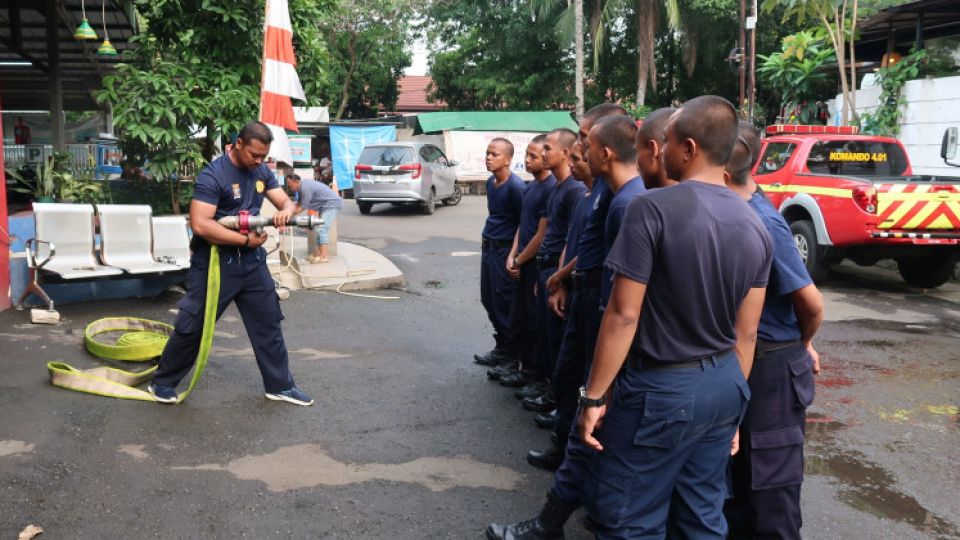November 13, 2025
JAKARTA – In a country where public services are often associated with long, bribery-ridden bureaucratic processes, firefighters stand out as a rare example of an institution that simply works.
Beyond extinguishing fires, they respond to calls to remove wasp nests, rescue buffaloes trapped in wells, or retrieve stuck valuables, often resolving these emergencies within minutes, a testament to their reliability and quick response.
One recent incident was reported by 24-year-old Tria Wulandari, who found a cat trapped inside a metal frame when she stopped by a convenience store in Batam, Riau Islands.
“The cat was meowing nonstop and sticking its paws through the metal frame, like it was begging for help. That’s when I realized it was trapped, and there was no way out. Everything was sealed,” she said.
Tria fed the cat while calling the local fire station, inspired by countless rescue clips she had seen on social media. In less than 15 minutes, firefighters arrived and freed the cat.
“They really showed up fast, just like on social media, and it was free of charge,” she said.
Similar stories have unfolded across the country. In Bandung, West Java, firefighters were seen in a viral video helping a woman remove a nose piercing stuck on a chair, drawing laughter from social media users. In East Jakarta, they helped a family bury a 210-kilogram relative at the Pangeran Jayakarta Public Cemetery. In South Jakarta, officers from the Kebayoran Baru Fire Station removed a 7-meter python from a residential neighborhood on Jl. Haji Nawi Raya.

Officer Priyatno checks his phone to monitor emergency alerts at Kebayoran Baru Fire Station in South Jakarta on Oct. 17, 2025, moments later the team received a request to catch a snake in a nearby neighborhood. PHOTO: THE JAKARTA POST
To the rescue
Priyatno, 34, a member of the rescue unit at the Kebayoran Baru Fire Station, said he has responded to all kinds of calls over the past eight years, from catching snakes and water monitors to rescuing trapped residents.
He once responded to a 2 a.m. call about a man locked inside his bathroom for two hours. Arriving within five minutes, he confirmed the resident was conscious and pried the door open.
Another officer at the same station, Daniel Fernando, 30, once helped a resident retrieve a smartphone that had fallen into Barito Lake and unlock a motorbike after the owner lost his key. In another late-night call, the two officers removed a metal perfume cap stuck on a child’s finger at 3 a.m. without injury.
Both Priyatno and Daniel said they find satisfaction in helping people, adding that their personal record is resolving an incident within 12 minutes of receiving a call.
Among the many calls they receive, some fall outside their authority, including investigating online scams, handling alleged spirit possessions and mediating household disputes.
“In South Jakarta, the reports we get can be bizarre. They say it because they trust firefighters, but we do not have the authority or capability to intervene in such incidents,” Priyatno said, adding that non-fire emergencies dominate calls at his station.

A snake lies coiled on the floor of Kebayoran Baru Fire Station in South Jakarta on Oct. 17, 2025. The creature had been captured earlier that day by firefighters responding to a resident’s call for help. PHOTO: THE JAKARTA POST
Jakarta Fire and Rescue Agency chief Bayu Meghantara said rescue calls, including animal control, retrieval of valuables and operations in hard-to-reach areas, now outnumber actual fire incidents.
The city handled 6,800 rescue calls last year, or about seven rescue operations for every two fire incidents, up from 6,586 in 2023.
“We are proud of the public’s trust in our firefighters and their ability to respond quickly to reports,” Bayu said.
Short-staffed, poorly equipped
Despite this high level of public trust, Indonesia still lacks sufficient firefighters and equipment, affecting both effectiveness and safety.
According to the Home Ministry’s Regional Administration Development Directorate General, the country has only 50,417 personnel handling more than 20,000 fire incidents nationwide last year.
Even Jakarta, which has the country’s largest regional budget, employs only 4,234 firefighters, half of whom are contract workers. Another 1,000 contract officers are scheduled to begin duty next year, still far short of the ministry’s recommended 11,200.
That shortage is evident in the field. A fire truck carrying 10,000 liters of water should ideally have at least six personnel, a driver, captain, firefighters, hose operators and a water operator, but in reality, trucks often operate with only three.
Other regions also suffer from inadequate firefighting equipment, a problem linked to the death of Martinius Reja Panjaitan, a 31-year-old firefighter from the Cimanggis Fire Station in Depok, West Java. He died in October last year after battling flames for over an hour without a self-contained breathing apparatus (SCBA).
Martinius’ death reignited calls for reform, led by his colleague Sandi Butar Butar, 33, known for his outspoken criticism of faulty firefighting gear and alleged corruption within the agency.
Sandi was dismissed by the Depok Fire and Rescue Agency last year but reinstated earlier this year following intervention by two regional heads.
Although firefighters face such shortages, they continue to demonstrate that public institutions in Indonesia can, in fact, work as they should.


